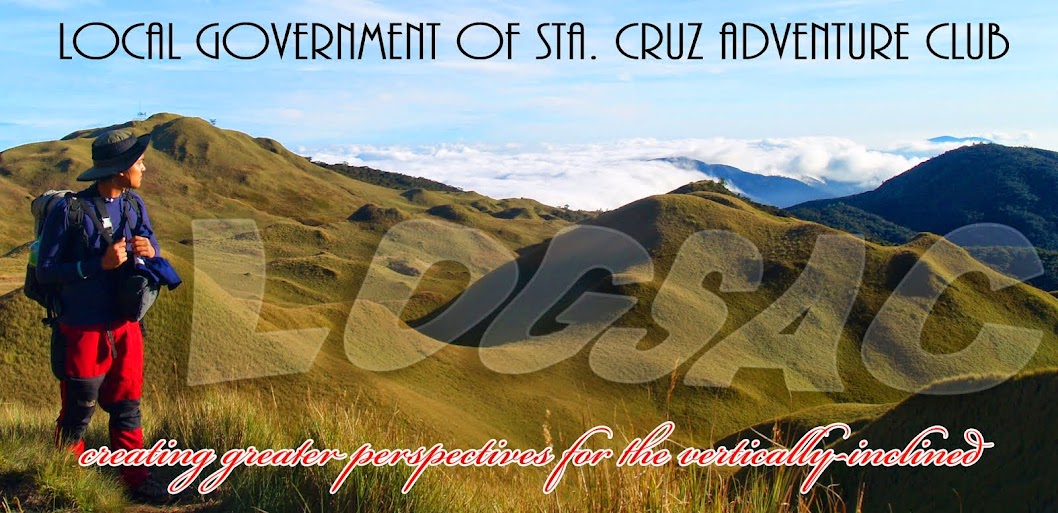From
total exploration of trekking trails my team suddenly had the urge to
rediscover an underground attraction in Sta. Cruz which I last visited ten
years ago. Yes, that is how long Saliducon Cave is being stepped anew by a human
foot. It has been left out in the ecotourism picture for quite some time
because there was a notion that it is connected with the present potable water
source and we chose not to disturb it for valid humanitarian intention. It was
only last year that this cave in Sta. Cruz is not at all intertwined with the
water concerns as confirmed by the Department of Environment and Natural
Resources (DENR) when the Saliducon Cave Development and Management Plan was
crafted and approved.
In
one of the salient components of the development plan I learned that ecotourism
was considered and that the DENR is aggressive in its stance to tap the local
governments, both municipal and barangay, to be partners in the said endeavour
not very far from now. Everybody obliged, of course.
On
June 5, we had a short caving here. Not a single weekend was missed by LOGSAC,
a hyper group which have been scratching wanderlust since day one of the
pandemic. This one though was a unique experience. After a short chat with
Barangay Captain Renon Sombilon of Saliducon, we drove a short paved road off
sitio Tibaol. I remember doing caving in Saliducon three times in a separate
trail in Melilia and the one we had last week was actually shorter and a lot
easier. Our guide was Nong Elmer Turado, a Barangay Tanod in Saliducon. A
20-minute single track of farmlands is required to reach the entry point of the
cave.
As
the only one with knowledge in caving (at least in Saliducon Cave) I conducted
a short orientation to the group. The night before this schedule Davao Oriental
was hit by an intensity 6.6 earthquake which left me in doubt of possible
aftershock and that could happen anytime while all of us are inside the cave.
Thank God there was no shaking that day. The entrance of this cave is very
small, enough for a single person’s body and if you are a certified heavy
weight you have no chance of going in here.
By
the way this is my fourth time in Saliducon Cave but I am still amazed by the
huge cobblestone formations distributed through all its chambers. This might not
be the best cave in Mindanao but it can be a really good site for minor
spelunking. Just like any other tropical caves, Saliducon Cave has an
attractive and wide caverns and some chambers where speleothems are found. I am pretty sure only few Sta. Cruzians have explored and witnessed the glory of this underground heritage in our place. The pictures below are some snaps for you to take glimpse of.
Cave
wildlife was also recorded during this visit. The Pit Viper I saw in 2009 was
no longer here for now but consistent dwellers are bats, crickets, millipedes
and Big-eyed Frog. Outside the cave perimeter are good bird species such as
Stripe-headed Rhabdornis, Amethyst Brown Dove, Philippine Serpent eagle, among
others.
It won’t be for long
and Saliducon Cave will be another good ecotourism site in Sta. Cruz. At this
point we are grooming the community to do most of the operation and
conservation at the same time. The fact that Saliducon and nearby barangays are
baskets of tropical fruits is a sure compliment.
Lastly, this adventure was the last time for LOGSAC with the company of the late Irvin Joy Alcoriza who chose to leave this world ahead of us on June 10. We fondly call him Joyjoy because he was a jolly, good fellow and had always been part of our adventures in the past. He is that person in the picture background of Mt. Pulag used as header of this website.
To you our brother, may you rest in peace. You now have a good adventure wherever you are.
P.S. Supplemental wildlife photos provided by Mr. Jake Caspi. Thank you.
P.S. Supplemental wildlife photos provided by Mr. Jake Caspi. Thank you.






































